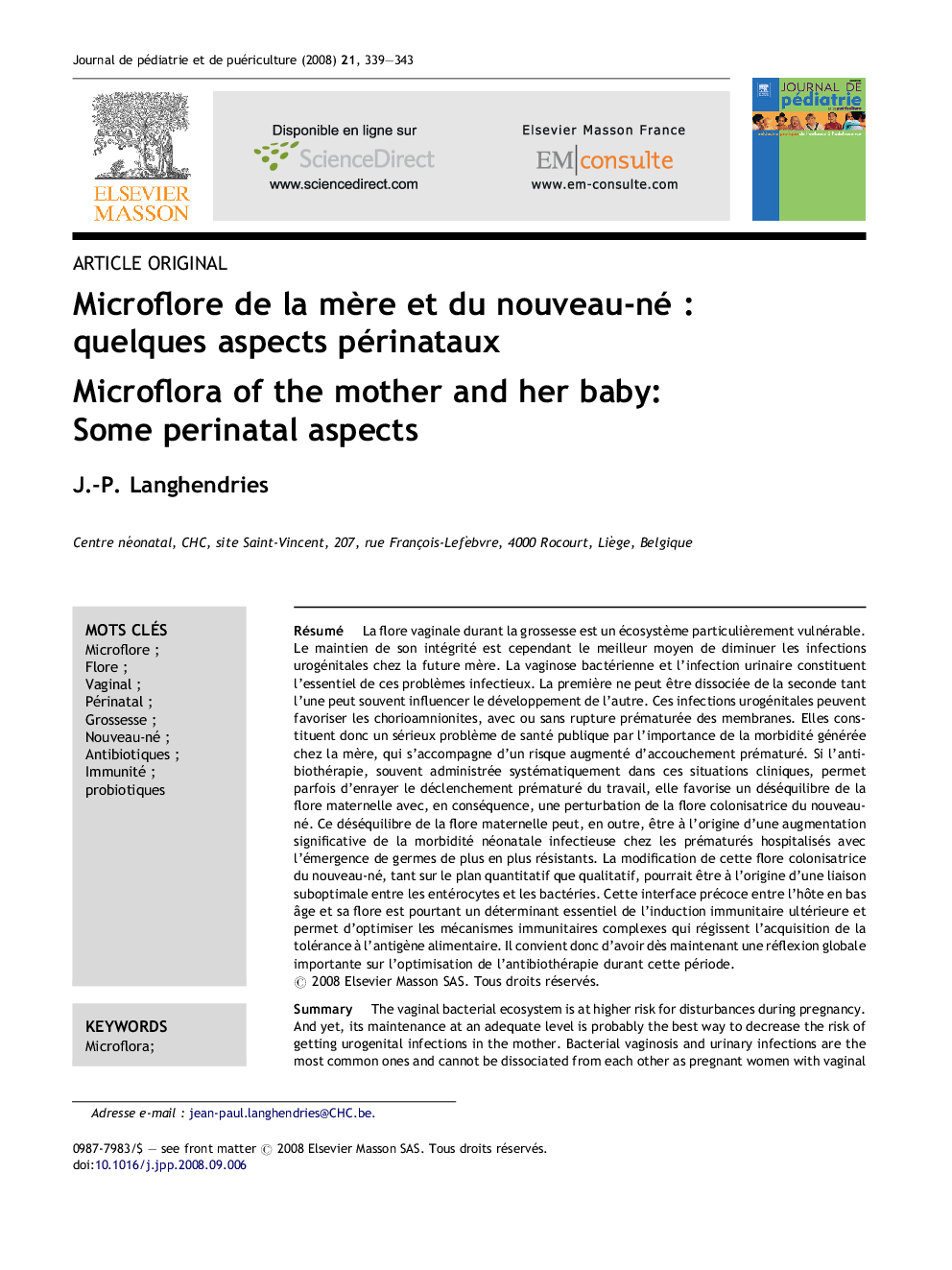| کد مقاله | کد نشریه | سال انتشار | مقاله انگلیسی | نسخه تمام متن |
|---|---|---|---|---|
| 4170321 | 1275454 | 2008 | 5 صفحه PDF | دانلود رایگان |

RésuméLa flore vaginale durant la grossesse est un écosystème particulièrement vulnérable. Le maintien de son intégrité est cependant le meilleur moyen de diminuer les infections urogénitales chez la future mère. La vaginose bactérienne et l’infection urinaire constituent l’essentiel de ces problèmes infectieux. La première ne peut être dissociée de la seconde tant l’une peut souvent influencer le développement de l’autre. Ces infections urogénitales peuvent favoriser les chorioamnionites, avec ou sans rupture prématurée des membranes. Elles constituent donc un sérieux problème de santé publique par l’importance de la morbidité générée chez la mère, qui s’accompagne d’un risque augmenté d’accouchement prématuré. Si l’antibiothérapie, souvent administrée systématiquement dans ces situations cliniques, permet parfois d’enrayer le déclenchement prématuré du travail, elle favorise un déséquilibre de la flore maternelle avec, en conséquence, une perturbation de la flore colonisatrice du nouveau-né. Ce déséquilibre de la flore maternelle peut, en outre, être à l’origine d’une augmentation significative de la morbidité néonatale infectieuse chez les prématurés hospitalisés avec l’émergence de germes de plus en plus résistants. La modification de cette flore colonisatrice du nouveau-né, tant sur le plan quantitatif que qualitatif, pourrait être à l’origine d’une liaison suboptimale entre les entérocytes et les bactéries. Cette interface précoce entre l’hôte en bas âge et sa flore est pourtant un déterminant essentiel de l’induction immunitaire ultérieure et permet d’optimiser les mécanismes immunitaires complexes qui régissent l’acquisition de la tolérance à l’antigène alimentaire. Il convient donc d’avoir dès maintenant une réflexion globale importante sur l’optimisation de l’antibiothérapie durant cette période.
SummaryThe vaginal bacterial ecosystem is at higher risk for disturbances during pregnancy. And yet, its maintenance at an adequate level is probably the best way to decrease the risk of getting urogenital infections in the mother. Bacterial vaginosis and urinary infections are the most common ones and cannot be dissociated from each other as pregnant women with vaginal bacteriosis are at increasing risk for urinary tract infections. These urogenital infections can favour chorioamnionitis with or without a rupture of membranes. The biochemical factors accompanying both infections are contributors of initiating the inflammatory cascade and by the end a preterm labour. Antibiotics can in part prevent or resolve these infections and are therefore very often used in clinical practice. However, these drugs will also further accentuate the vaginal dysbacteriosis favouring the colonisation of the vaginal tract of the mother and the intestine of the neonate with multiresistant microorganisms, realizing in such a way a real vicious circle. Birth is the only time in our life when the gastrointestinal tract, while sterile, is colonised by bacteria originating from the maternal flora as well as by that of the close direct birth environment. There is now evidence that the invasive microbial environment, first encountered during the birth process, is opportunistically used by the host to initiate its own defence mechanisms but also all immune mechanisms allowing oral tolerance to diet antigen. In fact, these mechanisms are still immature at that stage. Recent epidemiological data support the hypothesis that some increasing immune deviances observed in the last decades could have been originated from a modification of the bacterial environment in young populations. Our modern approach to perinatal care may, to some extent, have modified inadequately the overall quality of this bacterial–host interface. Keeping all above data in mind but without any denigration of each evidence-based data already got, which have been associated with an improvement of our perinatal care, it is nevertheless urgent to focus now on this maternal and neonatal bacterial environment at birth, which could have been secondarily modified. It is with the aim of finding the best way to ameliorate, in the future, the bacterial colonisation of the newborn. It is indeed of concern in terms of public health owing all these putative associated short and long terms morbidities in the mother and her baby related to the disturbances of the bacterial environment at birth.
Journal: Journal de Pédiatrie et de Puériculture - Volume 21, Issue 8, December 2008, Pages 339–343